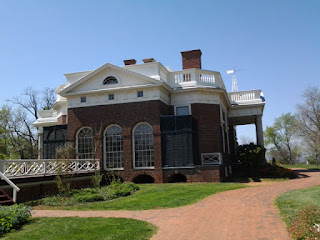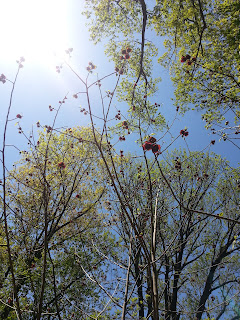With an IQ of 160 Thomas Jefferson could speak 5 different languages, read in 7 (Latin, Greek, French, Italian, Spanish, Old English and of course English). He would never read a translated book if he could read it in its original language. A lover of books - he famously wrote to John Adams "I cannot live without my books" - he had a passionate interest in science, invention, architecture, religion and philosophy, interests that led him to the founding of the University of Virginia after his presidency. He designed Monticello himself - taking 40 years to complete it to his satisfaction.
The design and building of Monticello was delayed by his time in Office - first as Vice President then two terms as President. He also spent 5 years in Paris, France as an overseas secretary of State where he studied French Architecture (which he found enthralling) so on his return he demolished the upper floors of Monticello and had them rebuild with much French influence. He also added the Octagonal Dome to the top floor.
The picture above shows the elongated sash windows much loved in Paris at that time - Jefferson had the top nine pane's added on his return but the window frame is actually an illusion - the windows belongs to the room above, on the next floor, which are set low to create the desired effect.
Jefferson also invented sash windows/doors for this house - working exactly as an ordinary sash window, there is actually 3 panels - enabling the lower 2 panels to be raised high enough to be used as a door. His other clever invention was skylights - he had them in several lower rooms to let light flood through. Always looking for efficiency and ease, he had a dumb waiter built into the fire surround in his dining room so the wine could come straight up from the wine cellar below. The dining room also had a shelved revolving door so that the butler could put the food on one side and turn it into the room - thus ensuring privacy for Jefferson's guests and their many in depth conversations.
Jefferson used local craftsmen as well as his own slaves to build Monticello. Though Jefferson owned many slaves, he opposed the institution all his life and consequently treated and took care of them very well and expected them to work no more than free farmers. They were allowed a day of rest on Sundays and he gave them cloth twice a year to make winter and summer clothing. He never sold his slaves on or broke up families and the women were encouraged to have children. Jefferson believed having children was the best work a woman could do.
He was keen for his plantation to run smoothly and efficiently - he encouraged his slaves to become multi skilled and let them use their skills to create their own economy on Sundays - their one day off. The top picture shows Mulberry Row which is when all slaves where housed and where they worked - producing food for the plantation as well as Ironworks and Nail production for construction.
Jefferson was meticulous about keeping records so The Thomas Jefferson Society have a first hand account of all details and numbers involved. From the slave headcount and family numbers to the amount of metal given to make the nails on a daily basis - Jefferson himself would weigh the days produce and note it in his ledgers.
The house remains lovingly restored and contains many of Jefferson's original items from furniture to books and Artifacts.
The entrance hall is a study of Native American Indians and contains gifts sent back from the Lewis & Clark expedition which he commissioned to explore the New West after he orchestrated the Louisiana Purchase - land purchased from France in 1803.
Unfortunately, due to the preservation of all these items its not possible to take photo's inside the house so here is a useful link - very interesting if you have the time.
http://www.monticello.org/site/house-and-gardens
I really loved my visit to Monticello and it was a beautiful day. As the local bus only goes as far as the entrance to the estate I decided to walk up the hill via Saunders trail. The bus driver assured me it was only a mile and half and would take about 20 minutes. Ha - muggins here believed him!!!! it was actually a 3 1/2 mile hike up the side of some quite steep terrain - good job I had my walking shoes on and that I needed to shift all those peanut butter laced bagels!!!!!
lovely flowering Dogwood
Saunders trail
As I said it was a beautiful day so I really enjoyed the trek and photographing some lovely flowering trees.
A fantastic end to my visit to Charlottesville.














No comments:
Post a Comment